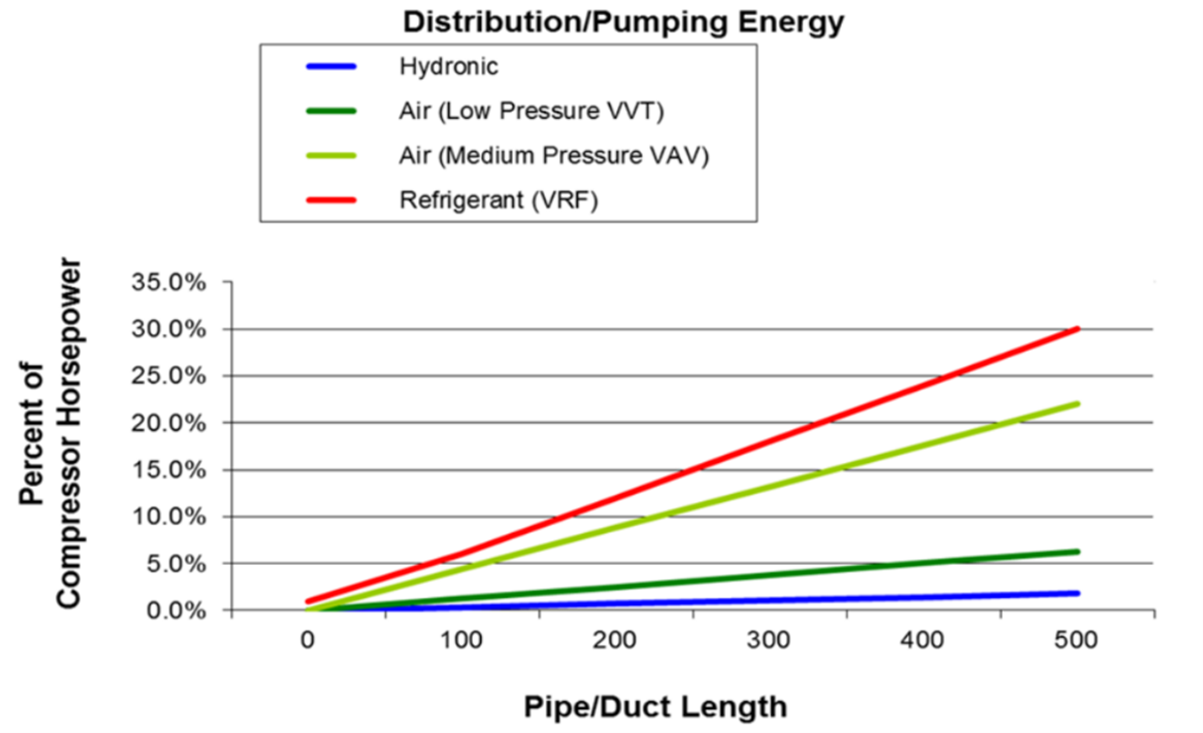Fact: To support the world’s population growth, it is estimated that some version of New York City is being built somewhere around the world roughly every 34 days for the next 37 years.
Fact: The built environment generates an estimated 40% of annual global CO2 emissions.
Fact: Decarbonizing our buildings is a critical step to meeting global climate goals.
How do we decarbonize? There are several methods, including building energy efficiency, electrification, LED lighting, low-GWP refrigerants, and renewable energy sources (both on- and off-site).
One solution in particular relates to building energy efficiency and can also include renewable energy as well. It’s radiant heating and cooling.
Exploring the Radiant Concept
In a radiant heating and cooling system, hot or chilled water circulates through a network of flexible, durable polymer pipes called PEX that are embedded in the concrete slab. By simply controlling the flow and temperature of the water, it efficiently and effectively controls the temperature of the slab, transferring heat in one direction or another — out from the slab for heating and into the slab for cooling.
To put it more clearly, circulating hot water uses the slab to radiate heat while circulating chilled water uses the slab to absorb heat.
One common question that arises when it comes to radiant cooling is,“When heating a space, it makes sense to heat from the floor. But shouldn’t cooling come from the ceiling because heat rises?”
Actually, no; heat does not rise. Hot airrises due to buoyancy based on the differences in density.
If heat doesn’t rise, which direction does it go?
To answer this question, we need to look at the second law of thermodynamics. More specifically, we need to look at the second formulation of the second law — known as the Clausius Statement — which states that heat will always naturally go from a high state to a low state (unless an outside source is influencing it).
For example, grabbing a hot coffee cup will transfer heat to your hand. However, grabbing a cold glass will transfer heat from your hand to the glass, leaving you feeling cold.
Hence, it does not matter if the surface being controlled is the floor, wall or ceiling; as long as there is a temperature difference (a delta T) between the controlled surface and the object and people within the space, there is always going be heat transfer.
Radiant heating and cooling systems also provide ideal human thermal comfort. Why? Well, looking at how the human body exchanges heat energy with the space around it, almost half of it is through radiation heat transfer. So, it makes sense that systems that rely on radiation heat transfer are more conducive to human thermal comfort.
Think of skin as a radiant surface where you are constantly exchanging energy with the space around you. The rate at which this energy either leaves or enters your body is based on the delta T between the space temperature and your skin surface temperature, leaving you with the sensation of feeling either hot or cold.
Discovering the Energy Efficiency of Radiant
Now that radiant heating and cooling has been defined, how exactly does it help contribute to decarbonization? Two of the most commonly applied solutions today are VRF systems and large VAV air handlers. Let’s see how radiant helps.
Several studies have shown that the farther the piping distance, the less efficient a refrigerant-based system becomes. Although proponents of VRF systems point out no circulators are needed to move refrigerant throughout a building, electrical energy still is required just to move refrigerant gas and liquid through piping.
That energy is supplied as electrical input to the system’s compressor(s). The electrical energy consumption for moving refrigerant through a VRF system, per unit of heat or cooling energy delivered, is significantly higher than that required for a well-designed hydronic system.
The graph below from IAPMO compares the energy required to move the cooling medium through a building.

The VRF system uses about 6% per 100 feet of refrigerant line set compared to the hydronic system, which uses only about 0.3 % per 100 feet of distribution distance.
Additionally, studies have shown that many VRF systems are conservatively measured at 50% below published energy efficiencies. This is because a real building requires multiple de-rates to the rated efficiency based on actual operation.
Variables in a real building include outdoor air temperature, length of refrigerant lines, elevation change between the condensing unit and indoor split units, indoor room temperature when cycling, actual airflow, constant versus variable room loads, and multiple other real-world operating differences from prescribed laboratory test points. Even oil migration in the refrigerant charge affects efficiency in reality.
When VRF systems are lab tested to find published integrated energy efficiency ratings (IEERs), the testing uses a 12.5-foot separation between the indoor and outdoor unit. In a building, there are likely to be hundreds of feet of copper refrigerant line installed. And, as outlined above, for refrigerant, distance is the No. 1 energy hog.
This is why, for maximum efficiency, water in a hydronic radiant heating and cooling system is the best option.
To further support this concept, a study by Lawrence Berkley National Labs (LBNL) compared a conventional VAV system with a radiant system coupled with a dedicated outside air system (DOAS). The study found that using a radiant system could save anywhere from 17% to 42% over the baseline VAV system. The graph below from LBNL shows significant savings comes from reducing the amount of air moving by using water to move those BTUs.

Essentially, the system is replacing fan motor horsepower with pump motor horsepower. Because water has the capacity to transfer energy 3,500 times more effectively than air, those BTUs can move much more efficiently with hydronic radiant.
Radiant systems also integrate well with renewable energy sources, such as geothermal and solar, making the systems even more energy efficient.
In Conclusion
Radiant systems using water are the most efficient, resilient solution for heating and cooling. Water is safe, cheap, easy to use, has a high thermal capacity and low viscosity, requires less monitoring, and is better for our environment.
These systems are an intelligent solution that integrate architecture and sustainable HVAC design, using a structure’s architectural elements to maintain comfortable spaces that are energy efficient and help achieve decarbonization goals.
Article originally appeared in Radiant Comfort Report Spring Edition as well as Plumbing & Mechanical magazines.

Hailey Mick
Hailey Mick is the engineering business development manager at Uponor. She can be reached athailey.mick@uponor.com. Click the link to see her presentation at the 2024 AHR Expo:Leveraging Radiant & Hydronics to Achieve Decarbonization Goals
Last modified: May 16, 2024

